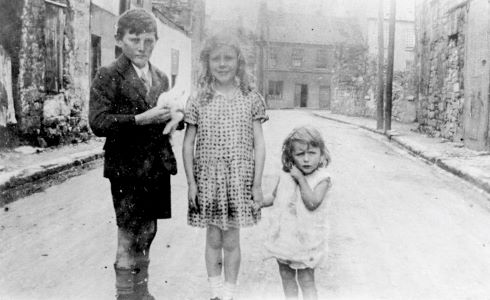Old Galway
THE SAVOY CINEMA

by Tom Kenny
In 1933, plans had been completed and passed by the Galway Urban District Council for a new cinema to be built on Eglinton Street by the famous baritone, Mr. Walter McNally. “The building will be beautiful and imposing, designed on the most up-to-date lines. The theatre will have seating for over 800 on the ground floor while the balcony will be capable of holding over 300”.
Middle Street, c1920

by Tom Kenny
Our photograph shows Olly Shea from High Street with his two cousins, the Brays from Father Griffin Road. They are standing in Middle Street which looks very wide with nothing parked there. The building on the far left was a tenement which later became a timber yard. Next door was a store which was owned by O’Gormans. The building beside that, with the white gable, was Tim Murphy’s; he ran a second-hand clothes shop there and carded wool. Next door was another tenement which was later taken over by Corbett’s timber yard.
Students rolling in money

by Tom Kenny
In 1961 a group of 11 students from UCG decided to roll a barrel from Galway to Dublin and to collect money for the relief of famine and suffering in the Congo on the way. They wanted to roll the barrel, but the bands fell off before they got to St Patrick’s Church, so they borrowed an old pram from someone.
THE CASTLE OF TÍR OILEÁIN

by Tom Kenny
The Library of Congress in Washington gave us this 1913 photograph of the ruins of the castle of Tír Oileáin, or Tirellan, sometimes wrongly referred to as Terryland, and now generally known as Oldcastle. It was strategically very important as it commanded the river at a point where there was a ford. It was a De Burgh castle.
THE LAST BOAT TO USE THE CANAL

by Tom Kenny
On March 8th, 1848, work was started on the Eglinton Canal. The Harbour Commissioners had been anxious to develop the New Dock. There were about 300 boats in the Claddagh and the amount of seaweed landed for manure in the spring of 1845 was 5,000 boat loads, averaging three tons each. The seaweed factory had been moved up to ‘The Iodine’, so the work on the canal was vital. It would allow boats to go from the Claddagh Basin up to the lake, boats from Cong and Maam to get to the sea and improve the mill-power on the Galway River.
THE CLADDAGH BASIN

by Tom Kenny
The actual cutting of what we now know as The Eglinton Canal began in March 1848. It provided much needed work during the Famine. It began at the Corrib Club and entered the sea near the Claddagh Church. The filling they dug out was used to fill terraces in UCG (which was also being built at the time) and to fill in the causeway behind Claddagh Quay. The Claddagh Basin and the Claddagh Quays were constructed especially to cater for the three hundred boats which were operating out of the Claddagh at the time.
The Guns in the Square

by Tom Kenny
The Galway Vindicator of July 25, 1857, reported the arrival in Galway on board the SS Lady Eglinton, of two cannon, which had been shipped from Woolwich Arsenal, the main storage and distribution depot of Crimean War ordnance. These cannon, described as “64-pounders of a heavy and clumsy description, each weighing two tons,” were taken from the docks to the goods yard beside the railway station, where they were made ready for the handing over ceremony. They were part of a significant amount of Russian ordnance which had been captured in 1854 by the 88th Regiment at the Battle of Inkerman during the Crimean War. They were two of a number of artillery pieces that were presented by the war department to various cities as trophies.
EYRE STREET AT THE TURN OF THE CENTURY

by Tom Kenny
Edward Eyre arrived in Galway with the Cromwellian army, became a major political figure and secured extensive grants from the Corporation and a considerable amount of property in both the city and county, mostly from displaced Catholic families, in the period 1660 – 1670. Most of this property was outside the town walls and included areas that we now know as the Railway station, Forthill Cemetery, Victoria Place, Merchant’s Road, the Commercial Dock, Woodquay, Suckeen and Eyre Square.
.png)